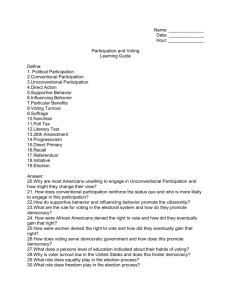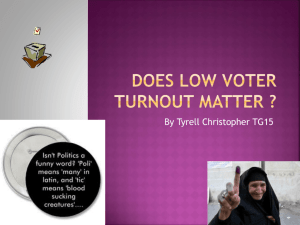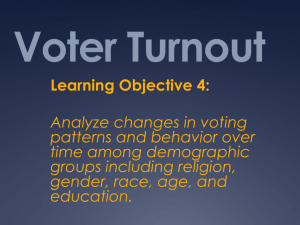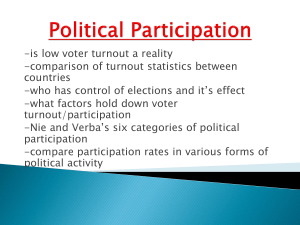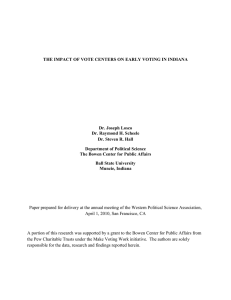Political Behavior
advertisement
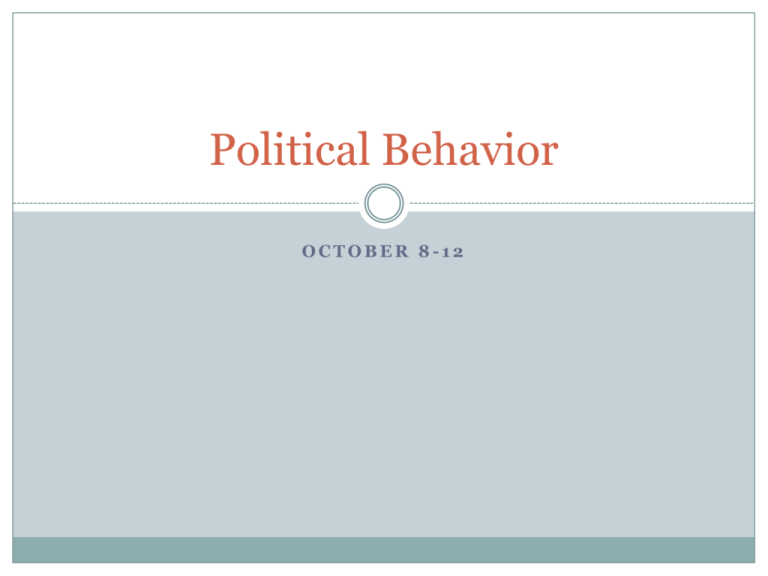
Political Behavior OCTOBER 8-12 Post-Test Discussion Our next unit will be on political behavior and political parties Do you think our country would run better without political parties? Why? Do you think political parties are a natural evolution for a democracy? Can a democracy exist without them? History of Voting Discussion Why do you think that some people wanted to prevent certain groups from voting? What were they afraid of? Do you think there should be any restrictions on who should vote? If so, what kind? Review Game http://www.americanbar.org/groups/public_educati on/initiatives_awards/conversations_on_the_consti tution/landingpage.html Responsibilities As people living in a democracy, we have certain responsibilities: Personal responsibilities (behaviors that impact self and family) Civic responsibilities (responsibilities of citizens in a political community that promote the common good) Responsibilities Personal – supporting one’s family, caring for and education one’s children, accepting consequences for one’s actions, living according to moral principles, respecting the rights of others Civic – obeying the law, paying taxes, respecting others’ property, keeping informed on issues, monitoring the actions of government leaders and agencies, voting, participating in civics groups, performing public service, serving as a juror, serving in the armed forces Voting As exciting as the last presidential election was for America, only about 57% of the people of voting age turned out to vote. Why do you think so few people vote? What excuses have you heard people give for not voting? Voting Do any of these reasons for not voting have legitimacy? Can any of them be remedied by government action? Which involve lack of personal or civic responsibility? Can students make suggestions for increasing voter turnout? Increasing Voter Turnout Each group gets one proposal. Use the CHECKLIST to evaluate the assigned proposal and recommend action on that proposal. Each group will report to the class on its recommendation. Voting Discussion Is there every a good reason not to vote? Why or why not? How do you think elections would be different if more people voted? Since so little of the population tends to vote, do you think people would be upset if they suddenly lost their right? Why or why not? Who Votes? Years in BOLD type are years when there was a presidential election. Years not in bold type represent years when only members of Congress were being elected and are called off-year elections. U.S. Representatives must run every 2 years and one-third of the U.S. Senate is up for re-election in any given election year. The percent turnout given reflects the ratio of actual voters to the number of people of voting age. The voting age population includes felons, mentally incompetent, resident legal immigrants and others who cannot register to vote. Who Votes? What happens to turnout when there is not a presidential election? It declines more than 10% What possible explanations exist for this decline in voter turnout? Less interest in Congressional elections, less media attention to them, people perceive the President to be more important to what happens in their daily lives (probably Congress with its lawmaking power actually influences their daily lives more), Explain that when an election is perceived by voters as going to be very close, they will turn out in greater numbers. This was true in 1960, when Kennedy defeated Nixon, Explain that when the country is at war or in crisis, turnouts tend to be higher. This was true in the 1960’s and in 2004 and 2008. Explain that when an incumbent President is running for re-election and the country is generally satisfied with his performance, turnout will go down. This was true in l996 and l972. When the country is unhappy with the incumbent, turnout can increase. This was true in 1992. Attractive, appealing candidates (those with charisma) can also increase turnout: Kennedy in 1960, Clinton in 1992 and Obama in 2008. Political Parties Throughout our history numerous parties have played a role in politics in our country. Sometimes parties are organized to reflect a general political philosophy, sometimes they are organized around a single issue, and sometimes they are organized around a single individual. Today, each student will represent one of the parties from our history and acquaint classmates with facts about that party. Political Parties Liberal - tend to look to government to solve problems, the “left” on political spectrum Conservative - believe in traditional values, less government, the “right” on political spectrum Grassroots democracy – local level political organization Ideology – manner of thinking, characteristic of a group Political Parties Party platform – a political party’s stance on issues Platform plank – one topic in a party’s platform Populist – believer in the rights and wisdom of the common people Faction – a group within a party, usually marked by dissention Ballot status – qualifying to have one’s name on the ballot. Varies from state to state, can be by paying money or getting signatures of registered voters Political Side-Step Study your party descriptions Divide the class in half. Form two lines facing each other. Designate one line as Line A and the other is Line B. Spread out as much as possible. Step forward to meet the person in front of you. Introduce yourself and then explain your party’s history and philosophy to your partner from the other line. Using the Handout: Political Side-Step Dance Card Notes, list at least 5 facts about the parties they are encountering. After approximately one minute, you will be given a signal to move as outlined below: LINE B does NOT MOVE. Students in LINE A only move one person to the LEFT. The person on the left end of the line moves to all the way to the other end of the line. Again introduce yourself to your partner, explain your party’s history and philosophy to your new partner, and add notes to you Dance Card. Continue rotating until you have returned to your original place in line. (On the last rotation you may be asked to publicly introduce the person opposite you, since those in each line never meet each other.) Post Side-Step Answer these on a separate sheet of paper to be turned in tomorrow: Which two parties were organized first in our country? Who was the first man elected President as a Democrat? As a Republican? Which of those two parties is the oldest? Which of those two parties has had the most people elected President? Which third party is believed to have played a role in determining the outcome of the 2000 election? What historic party developed in opposition to Andrew Jackson’s policies? Name at least three parties that can be defined as single-issue parties. Which parties seem to have been organized mainly around one individual? Party Platform It is a personal choice whether or not to participate in or identify with a particular party One “joins” a party simply by saying they identify with that party. No dues are paid to be a member of a political party. Platforms are written every four years at the parties’ national nominating conventions. Committees representing people from all states begin researching the platforms weeks in advance of the convention, holding hearings to get input from grassroots members of the party. The convention delegates vote on the platform early in the convention, and can reject or change proposals put forth by the platform committee. Each topic in the platform is referred to as a “plank.” Party Platform Party platforms are written in broad, general language rather than getting into specific details or going to extremes. Both parties must appeal to the electorate as a whole for votes. Both platforms do not always address the same ideas. Just because a party is silent on an idea does not necessarily mean they dislike the idea – they just may not have thought to include it. Sometimes parties agree in principle on an issue, but may differ on how to carry the idea into practice. People rarely agree with every stance a party takes on issues, but they generally agree with a party’s overall philosophy. When deciding on a party to support, voters must consider which issues are the most important to them.
